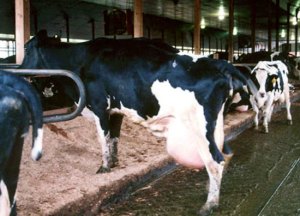Who doesn’t wish that all healthy foods were as easy to eat as yogurt in a plastic tube? Sweetened and in a variety of

Credit: http://www.sugarstacks.com
fruit flavors, ads show how kids don’t even have to get off their skateboards to enjoy yogurt anymore. Long touted as an exemplary healthy food – chock full of vitamins, minerals, and recommended fats – yogurt is also “alive”. Cultured with various probiotic strains, including Lactobacillus bulgaricus, Lactobacillus acidophilus, Streptococcus thermophilus and bifidobacteria, yogurt is a good digestive boost and immune system enhancer. Depending on the type of milk used to make the yogurt, however, there could be other not-so-great microscopic bits kids are sucking down on the go.
It is not too much of a stretch to claim antibiotics are the backbone of Western medicine. They are commonly used to treat serious infections, fungal outbreaks, and even the common cold. Nowadays, you can dose up on antibiotics each time you eat dairy – including yogurt, such as the one described in the recipe below:
INGREDIENTS: Cultured Pasteurized Grade A Milk, Sugar, Nonfat Milk, high Frustose Corn Syrup, Modified Corn Starch, Kosher Gelatin, Tricalcium Phosphate, potassium Sorbate (To Maintain Freshness), Carrageenan, Natural And Artificial Flavor, Colored with Carmine.
PROCEDURE:
1. Cram thousands of cows into a small space. Conventional dairy cows live in Confined Animal Feeding Operations (CAFOs), meaning a minimum of 700 cows are living in an unvegetated area – either in or outdoors – for a minimum of 45 days. These cows spend most of their lives sick, pregnant, and walking around in a sludge of their own manure – it’s no wonder most of us have never seen a dairy operation: who would drink milk anymore?
2. Feed them corn until they’re sick. Cows normally eat grass, but there isn’t enough to go around in a standard CAFO. Instead, cows are fed corn (cheap thanks to government subsidies) that often makes them sick. Cows have also typically been given artificial growth hormones to increase milk production, resulting in severe cases of mastitis among other serious illnesses.
3. Shoot ’em up with meds so they don’t look sick. Instead of abandoning the practices that make the cows sick in the first place, antibiotics are routinely added to the dairy cows feed and antimicrobial shots are commonly administered. These meds end up in our milk supply, and have been linked to consumer allergic reactions as well as the increased growth of antibiotic resistant bacteria. It’s not unfathomable to say that those antibiotics the doctor prescribes may not do any good one day soon, due in part to the overuse of them in our milk and meat production systems.

Dairy cow with Mastitis (Credit: advocacy.britannica.com)
4. Milk them – even if they’re sick. Enough said.
5. Replace the natural probiotics with sugar and preservatives. Legally, milk can only be sold in most states if it has been pasteurized, a process required to kill the harmful bacteria the CAFO system has made common in most milk. Thus, the natural enzymes and probiotics that naturally occur within the yogurt-making process must be artificially added in. In the case of the above ingredient list, however, this was not done. In essence, the “yogurt” in a tube – marketed mainly to young children – is processed milk enhanced by sugar, corn syrup, artificial flavorings, and preservatives. None of these additions offer the enhanced digestive and immune benefits of true yogurt (although the additional antibiotics may be a good marketing point as a means of preventing infection).
6. Seal it up in a plastic tube. Like Space Food. Although there is too much to say here for this blog, it is worth mentioning that the incredible amount of packaging is also a serious environmental issue, not to mention the cultural issues with a food that encourages kids to eat on the go and away from the family table, or even the ethical issue of such an unhealthy product being directly marketed to children. (Ah, but mom, look how cool it is – I can eat it AND play Nintendo at the same time!)
Eat outside the box: Buy organic or locally produced milk that is free of artificial hormones and antibiotics – or better yet, find a good farm nearby and switch to fresh raw, grass-fed milk – and make your own yogurt. This yogurt recipe is super easy to make at home – and if you’re interested, read about milking the (antibiotic-free) goats who provided the milk!